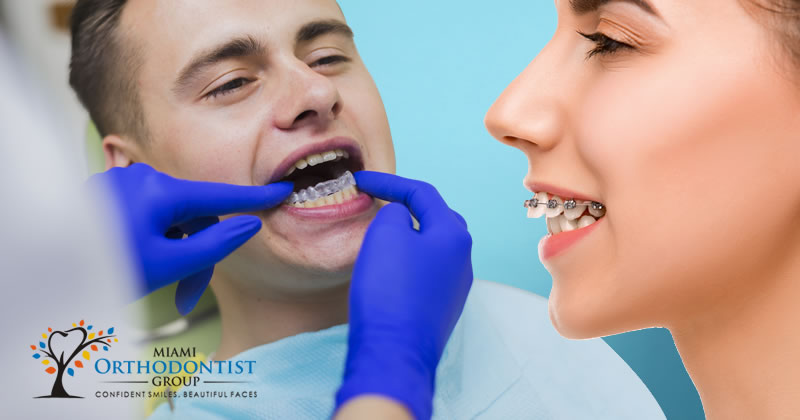Orthodontic treatment, including the use of appliances like braces and clear aligners, often raises many questions for those seeking to improve their smile. People seeking Orthognathic Surgery in Miami or Emergency Orthodontics frequently wonder about which type of orthodontic appliance is best for their needs, especially when considering the pros and cons of braces vs. clear aligners.
Braces vs. Clear Aligners: Choosing the Best Orthodontic Treatment for Your Smile
Let’s dive into these options and explore the main features and benefits of each:
Braces
Braces have been a staple of orthodontic treatment for many years and continue to be an effective way to treat a variety of orthodontic issues, such as crooked teeth, bite problems, and jaw misalignment.
Types of Braces
Modern braces come in various materials, including:
- Stainless Steel: The classic, durable choice for braces.
- Tooth-Colored Ceramic: A less noticeable option for those who want a more discreet treatment.
- Gold-Colored: A more fashionable, but still visible, option.
Although newer options like tooth-colored brackets can reduce visibility, features like rubber bands and wires may still be visible. The good news is that patients often have the option to choose the color of their rubber bands, adding a bit of personalization.
Key Benefits of Braces
- Efficiency: Braces stay attached to your teeth throughout the treatment process, providing consistent and reliable pressure to shift your teeth.
- Effectiveness: They can treat a wider variety of orthodontic issues, including more complex cases of tooth misalignment or jaw irregularities.
Considerations for Braces
- Discomfort: Initial placement and adjustments can cause temporary discomfort or irritation to the gums. This discomfort usually fades once the braces are settled in.
- Dietary Restrictions: Certain foods (like chewy, sticky, or hard foods) should be avoided to prevent damage to the brackets or wires.
- Oral Hygiene: Braces require careful maintenance. Patients need to brush and floss carefully to avoid plaque buildup, which can lead to tooth decay or gum disease.
Clear Aligners
Clear aligners, like Invisalign, are an innovative solution that has become increasingly popular in recent years. They are transparent plastic trays that are custom-made to fit over your teeth and gradually shift them into place.
Key Features of Clear Aligners
- Discreet: Clear aligners are nearly invisible, making them a popular choice for people who want to undergo orthodontic treatment without the visible appearance of traditional braces.
- Removable: Aligners can be taken out when eating, brushing, and flossing, offering greater flexibility and convenience. This is a major benefit for many patients, as they don’t need to worry about food getting stuck in braces.
Key Benefits of Clear Aligners
- Comfort: With no wires or brackets, clear aligners are generally more comfortable than traditional braces. There’s less chance of irritation to the inside of your mouth.
- Convenience: You can remove them to eat or brush your teeth, which can make maintaining oral hygiene easier.
Considerations for Clear Aligners
- Discipline Required: Aligners need to be worn for at least 22 hours a day to be effective. Missing this time can delay treatment.
- Risk of Misplacement: Since aligners are removable, they can be lost or misplaced if not handled carefully.
- Attachment Requirements: Some patients may require small tooth-colored attachments to help align the teeth properly. These attachments may make the aligners more visible than they initially appear.
Which Is Best for You?
The decision between braces and clear aligners depends on several factors, including:
- Complexity of the Case: Braces are often better for more complex dental issues, such as severe misalignment or bite problems.
- Aesthetic Preferences: Clear aligners are a great option for people who prefer a more discreet treatment.
- Lifestyle Considerations: If you have a busy lifestyle and are concerned about keeping your braces clean or avoiding certain foods, clear aligners may be more convenient. However, if you prefer a set-it-and-forget-it approach, braces might be better.
Consultation with an Orthodontist
For an accurate treatment plan, it’s important to consult with a Best Orthodontist in Miami who can evaluate your unique needs through a detailed examination, including X-rays, photos, and molds of your teeth. The orthodontist will tailor the treatment based on your specific orthodontic problem and guide you toward the best solution—whether that’s braces, clear aligners, or even orthodontic surgery for more severe cases.
Ultimately, both braces and clear aligners have their advantages. It’s all about finding the right fit for your needs, lifestyle, and goals.

